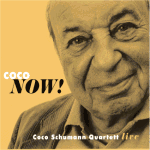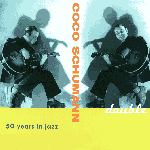 From the underground
of Berlin, to Theresienstadt, from Auschwitz to Australia, from the Berlin
'Red House' to the 'Ewigen Lampe' back to swing. A cross section through
the life of the musician Coco Schumann. Coco Schumann, one that studied
the high education of Jazz in Berlin of the late thirties, that gained experiences
in improvising, submerging, surviving- one that's life was saved by music.
Weather as first German electrical guitar player with the 'Helmut Zacharias
Quartett' or at radio-pop-recordings, or with 'Leo Rosners Gipsy Band' in
Australia or tomorrow in the 'Ewigen Lampe' in Berlin, he was and still
is always distinguished by his unique feeling for the swing. One of the
few still active Jazz musicians in Germany, that gained their first musical
experiences in the thirties, is the guitar player Coco Schumann. Heinz Jakob
Schumann was born in Berlin 1924 and as half Jewish he had to learn growing
up really quick. His love for music helped him: In 1936 he already was infected
by the 'Swing-Virus' and he still is not cured . 1936 in Berlin, that meant
'The Olympic Games', but also a little more freedom in the music for that
what was called a little later 'Niggermusic'. Coco, as he was called soon,
was at first only a 'fence guest' in the big dancehalls of those days, he
for example listened to the big Swing-Idol Teddy Stauffer at the Delphi.
But he was part of it soon, learned by playing, went through a unique school,
a career, that would be almost impossible today. A crucial reason therefore
was his special feeling for the swing. Exactly that feeling, that he is
envied for, by many young guitar players. This was followed by the time
of hidden and forbidden appearances in bars and basements in Berlin, and
finally by denunciation, arrest and kidnapping to the concentration camps
Theresienstadt, Auschwitz, Dachau. He only survived with the help of his
music, weather as part of the 'Ghettoswingers' in Theresienstadt, or when
he was forced to play the song 'La Paloma' for the twenties time in Auschwitz.
For many years he wouldn't talk about these experiences, today he sees an
obligation to fight against forgetting these times. After the war he reconnected
with the Jazz-Scene, he played with Helmut Zacharias, became the first German
musician with an electrical guitar, finally immigrated to Australia and
then came back after a few years. Coco Schumann never categorized his music
strictly and also had no problems with more common forms of music. That
is how he accompanied the story of the German popular music, the recordings
at some radio stations and also his own composing work. Whatever he does,
weather he plays at Jazz-Concerts or in dancehalls he always stays faithful
for his audience and himself: the music is the main thing, the feeling for
the rhythm and for the moment.
From the underground
of Berlin, to Theresienstadt, from Auschwitz to Australia, from the Berlin
'Red House' to the 'Ewigen Lampe' back to swing. A cross section through
the life of the musician Coco Schumann. Coco Schumann, one that studied
the high education of Jazz in Berlin of the late thirties, that gained experiences
in improvising, submerging, surviving- one that's life was saved by music.
Weather as first German electrical guitar player with the 'Helmut Zacharias
Quartett' or at radio-pop-recordings, or with 'Leo Rosners Gipsy Band' in
Australia or tomorrow in the 'Ewigen Lampe' in Berlin, he was and still
is always distinguished by his unique feeling for the swing. One of the
few still active Jazz musicians in Germany, that gained their first musical
experiences in the thirties, is the guitar player Coco Schumann. Heinz Jakob
Schumann was born in Berlin 1924 and as half Jewish he had to learn growing
up really quick. His love for music helped him: In 1936 he already was infected
by the 'Swing-Virus' and he still is not cured . 1936 in Berlin, that meant
'The Olympic Games', but also a little more freedom in the music for that
what was called a little later 'Niggermusic'. Coco, as he was called soon,
was at first only a 'fence guest' in the big dancehalls of those days, he
for example listened to the big Swing-Idol Teddy Stauffer at the Delphi.
But he was part of it soon, learned by playing, went through a unique school,
a career, that would be almost impossible today. A crucial reason therefore
was his special feeling for the swing. Exactly that feeling, that he is
envied for, by many young guitar players. This was followed by the time
of hidden and forbidden appearances in bars and basements in Berlin, and
finally by denunciation, arrest and kidnapping to the concentration camps
Theresienstadt, Auschwitz, Dachau. He only survived with the help of his
music, weather as part of the 'Ghettoswingers' in Theresienstadt, or when
he was forced to play the song 'La Paloma' for the twenties time in Auschwitz.
For many years he wouldn't talk about these experiences, today he sees an
obligation to fight against forgetting these times. After the war he reconnected
with the Jazz-Scene, he played with Helmut Zacharias, became the first German
musician with an electrical guitar, finally immigrated to Australia and
then came back after a few years. Coco Schumann never categorized his music
strictly and also had no problems with more common forms of music. That
is how he accompanied the story of the German popular music, the recordings
at some radio stations and also his own composing work. Whatever he does,
weather he plays at Jazz-Concerts or in dancehalls he always stays faithful
for his audience and himself: the music is the main thing, the feeling for
the rhythm and for the moment. |
 |
 |
 |
Coco
Schumann
Coco Now!
CD-0226-E/U |
 |
 |
 |
Coco
Schumann
50 Years In Jazz
CD-0238-K |
 |
|
|

